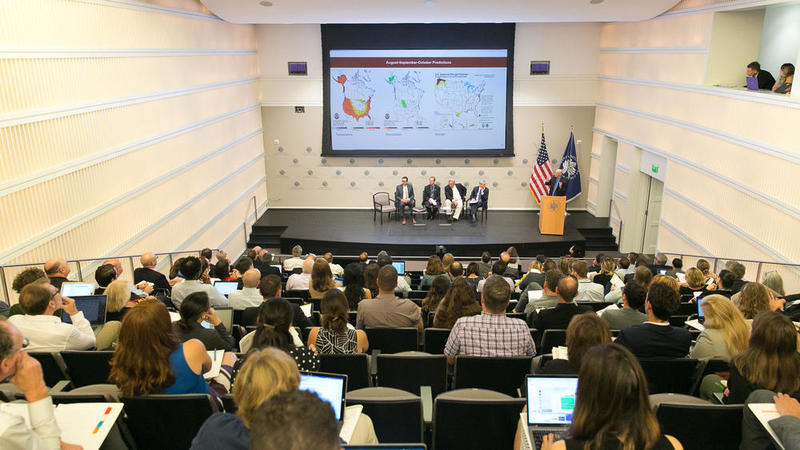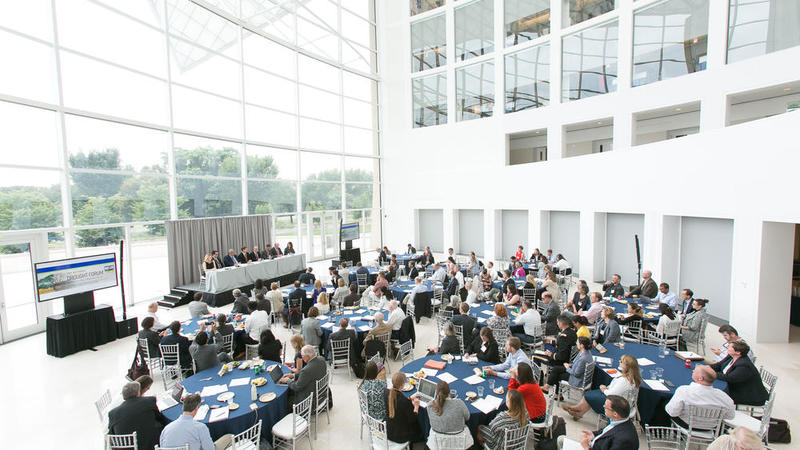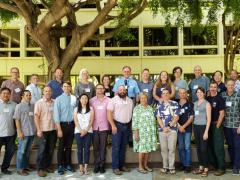Highlights From the 2nd National Drought Forum
The 2nd National Drought Forum, held July 30-31 in Washington DC, convened high-level drought experts and decision-makers from drought-impacted regions and economic sectors of the country, along with the private sector, research institutions, and officials across all levels of government to discuss priority actions around drought early warning, long-term resilience, and the billions of dollars lost to drought in the U.S. each year.
The goals of the meeting were to:
- Take stock of lessons learned and progress toward U.S. drought readiness since the last Forum in 2012.
- Strengthen the state-federal relationship to realize greater collaboration and promote, where appropriate, cooperative partnerships with U.S. businesses to address drought across time scales and across levels of government and sectors.
- Discuss new information and opportunities for coordination that help move the Nation from a reactive to a proactive approach to drought risk management.
- Produce a list of clear “action items” that could improve U.S. drought readiness and resilience
Below are some highlights from the two-day Forum. A full Forum Report will be produced this fall and will include all the highlights, key takeaways, and action items.
-- Click here to see the full list of Forum moderators and panelists. –
Day 1, Tuesday, July 30
Linking National Security and Drought (Panel)
This session focused on how the U.S. depends on vital, up-to-the-minute drought information for preparedness, response, and recovery for both public safety and the protection of the Nation’s critical infrastructure and natural resources.
- Domestic drought can affect military readiness by reducing training exercises due to wildfire threat and heat issues.(Vice Admiral Lee Gunn USN (Ret), CNA Military Advisory Board)
- International drought causes migrations and instability, such as the conflict in Syria. (Vice Admiral Lee Gunn)
- The military and national security apparatus needs to anticipate water shortages to prepare for associated humanitarian and security issues. (Vice Admiral Lee Gunn)
- We need to look at successes in managing drought and learn from the areas and communities that do well in identifying risk and preparing for those risks. (Dr. Gerry Galloway, Jr., University of Maryland)
Drought Conditions: Past, Present, and Forecasted (Panel)
This panel presented on major drought events since the 2012 Great Plains Drought, the accomplishments in the intervening seven years, the role of intergovernmental coordination in drought response, and current drought conditions and the forecasted outlook.
- The floods of 2019 lasted 3½ months. Some of the areas that flooded are now in, or almost in, drought. We need to be able to identify and predict with greater assurance the onset of severe weather. (Honorable Mike Bawden, Mayor, Riverdale, IA and Mississippi River Cities and Towns Initiative)
- California experienced many negative impacts from the recent drought such as orchards being removed, public health issues like West Nile Virus, massive wildfires, and $3.3 billion losses in the San Joaquin Valley. But the drought also led to innovation and changed behaviors. (Honorable Daron McDaniel, District 3, County of Merced, CA, and Rural County Representatives of California)
- The signals in predicting the California drought were opposite of what we’d normally expect, putting some of our assumptions to question and indicating that we need to do more research. (Dr. David Dewitt, Climate Prediction Center, NOAA)
- We can’t forecast precipitation as a science community beyond about two weeks at a time. (Dr. David Dewitt)

Drought Decisions around the New (Ab)Normal: Water Scarcity, Drought, and Aridity (Panel)
This panel discussed the implications of water management decision-making under increasingly arid conditions. In particular, panelists explored: (1) the role of existing water infrastructure in arid environments and investment-based repurposing of infrastructure for drier conditions; (2) opportunities consistent with the Presidential Memorandum on Promoting the Reliable Supply and Delivery of Water in the West; (3) the use of natural water storage as an effective response to a more arid future; (4) the U.S. Farm Bill and opportunities for Western irrigated agriculture; and (5) associated research priorities.
- Drought preparation involves much more than the public sector: insurance, infrastructure, and banks are integral to planning. (Dr. Upmanu Lall, Columbia Water Center)
- The West’s storage reservoirs capture 5‒10% of the West’s snowpack (depending on the water year). We need a landscape-scale distributed response—natural features that retain and slow down the flow of water across the landscape. This will help not only flooding but also drought by allowing recharge of surface water and groundwater. (Laura Ziemer, Trout Unlimited)
- We used to be very good at water allocation, but the ability to manage into the future is being confounded by events like the likelihood of megadroughts. (Astor Boozer, U.S. Department of Agriculture)
Lunch Keynote by Joaquin Esquivel, California Water Resources Control Board Chair
- The recent California drought changed the way the state looks at drought. There was a shift in understanding our vulnerabilities.
- We need to convert data into actual information to make better decisions. Decision-support tools are also important as a way to better respond to drought challenges.
- How do you take what is generally accepted as a collection of good things we should do and place metrics around them so that you can assess how we are doing? How do you set resilience targets? How do we set framework, metrics, and targets to further move forward on water? In answering these questions, there is a generational opportunity to look at how we manage water differently.
Economics of Drought Part I: Understanding the Cost of Drought (Panel)
This panel featured representatives from diverse sectors to discuss how drought is impacting bottom lines and ecosystems throughout the country and how we can better measure those economic impacts.
- Lake Mead faces a 35% risk of falling below 1,000 feet in 2026. At that level, Lake Mead is only at 17% capacity and access would be lost to two intakes with limited ability to meet demands. Over $800 million was allocated, funded by ratepayers, to insert a lower intake into Lake Mead. (Colby Pellegrino, Southern Nevada Water Authority)
- Right now we don’t have good information on quantifying drought impacts on ecosystems. Drought resilience strategies designed to benefit humans can also yield ecosystem benefits. (Tom Iseman, The Nature Conservancy)
- Summer 2017 was the worst fire season in Montana in decades. This caused a lot of issues with air quality—it was not healthy to go outside and do physical activities. The state lost 800,000 visitors in the third quarter of 2017 and $240.5 million in visitor spending. When people don’t visit there are cascading effects: employees don’t get paid and people can’t pay rent. (Jan Stoddard, Montana Office of Tourism and Business Development)
Day 2, Wednesday, July 31
Opening Remarks by Neil Jacobs, Acting Administrator, NOAA
- We have a big data problem—this is a bottleneck. We pull in several terabytes for every cycle but if we can’t use it, we can’t put it into the forecast model. Only 8% of the data we get from satellites are put into the model.
- It is in our best interest to enable the community to run the model. Community is a force multiplier for further development.
- Improvements in forecasting can be made with physics and data assimilation—this is where the European system is superior and this is where we’ll see improvements in precipitation forecasting.
- A focus on ocean modeling and coupling it with the atmospheric model will improve forecasting skills beyond 3 weeks.
Economics of Drought Part II: Risk Analysis and Investments that Drive Innovation (Panel)
This panel brought together private sector and government representatives to discuss drought risk analysis and decision-making, illuminating new financing solutions for drought resilience, cost of drought to cities and bond ratings for flood and drought resilience, and insights into how industry metrics are changing in the context of drought.
- We need to have an asset management conversation in regards to climate and drought—how we’re siting infrastructure or making changes incorporating drought or climate data.
- Corporations think short term when spending money. Leadership of drought impacted companies need to get beyond that if they’re going to be prepared. We need to take steps that might not have immediate return. (Jon Radtke, The Coca-Cola Company)
Drought Policies: Congressional Perspectives (Panel)
In this panel, congressional staffers discussed recent and potential legislation, including the Farm Bill, NIDIS Reauthorization, the Water Resources Development Act, and legislation tackling water infrastructure, soil moisture monitoring, and other issues.
- The 2018 Farm Bill included an update to the US Drought Monitor, improvements to the regional conservation program, increased funding for the environmental quality incentives program, and the Watershed Act to help federal, state, tribal, and local to restore and protect watersheds up to a certain acreage. (Rosalyn Brummette, U.S. Senate Agriculture, Nutrition, & Forestry Committee)
- Whether it is flood or drought, how do we manage a system built in the last century to attack challenges today? (Camille Calimlim Touton, U.S. House Committee on Transportation and Infrastructure)
- Some farmers are concerned that the US Drought Monitor doesn’t reflect their local conditions. We know there is a gap in soil moisture monitoring. (Dr. Fern Gibbons, U.S. Senate Committee on Commerce, Science, and Transportation)
Drought Coordination: Federal Water Officials and the National Drought Resilience Partnership
Federal Water Officials shared their key drought issues and opportunities. Then, National Drought Resilience Partnership (NDRP) Co-Chairs, Bill Northey, Undersecretary of Farm Production and Conservation, USDA, and David Ross, Assistant Administrator for the Office of Water, EPA, provided background context for what progress has been made between 2012 and today on Federal coordination, and announced the release of a new document on Priority Actions Supporting Long-Term Drought Resilience.

Monitoring and Forecasting of Drought (Panel)
Over the past seven years, advances have been made in monitoring and forecasting of drought, but many challenges remain. This panel identified priority needs for strengthening existing capabilities in monitoring and forecasting, as well as applied research, to build our nation’s drought early warning capacity.
- Similar to the U.S. Drought Monitor, a hypothetical U.S. Water Monitor could include moderate surplus, extreme surplus, etc. and be a complementary product with supply and demand. (Dr. Mark Svoboda, National Drought Mitigation Center)
- The product, Climate Engine, has the goal of processing satellite and climate data at a variety of scales using cloud computing to drill down from global to field scale in a number of seconds. (Dr. Justin Huntington, Desert Research Institute)
- To build a drought early warning systems, we need to mine historical data and paleodata, modernize water observing systems, integrate access to other observing systems, advance water modeling and prediction, and integrate decision support. (Dr. Don Cline, U.S. Geological Survey)
Priority Actions for Improving National Drought Readiness
The forum closed with the participants sharing the ideas and recommendations they heard over the previous two days. These recommendations will be captured in the full report of the Drought Forum coming this fall. Stay tuned!




